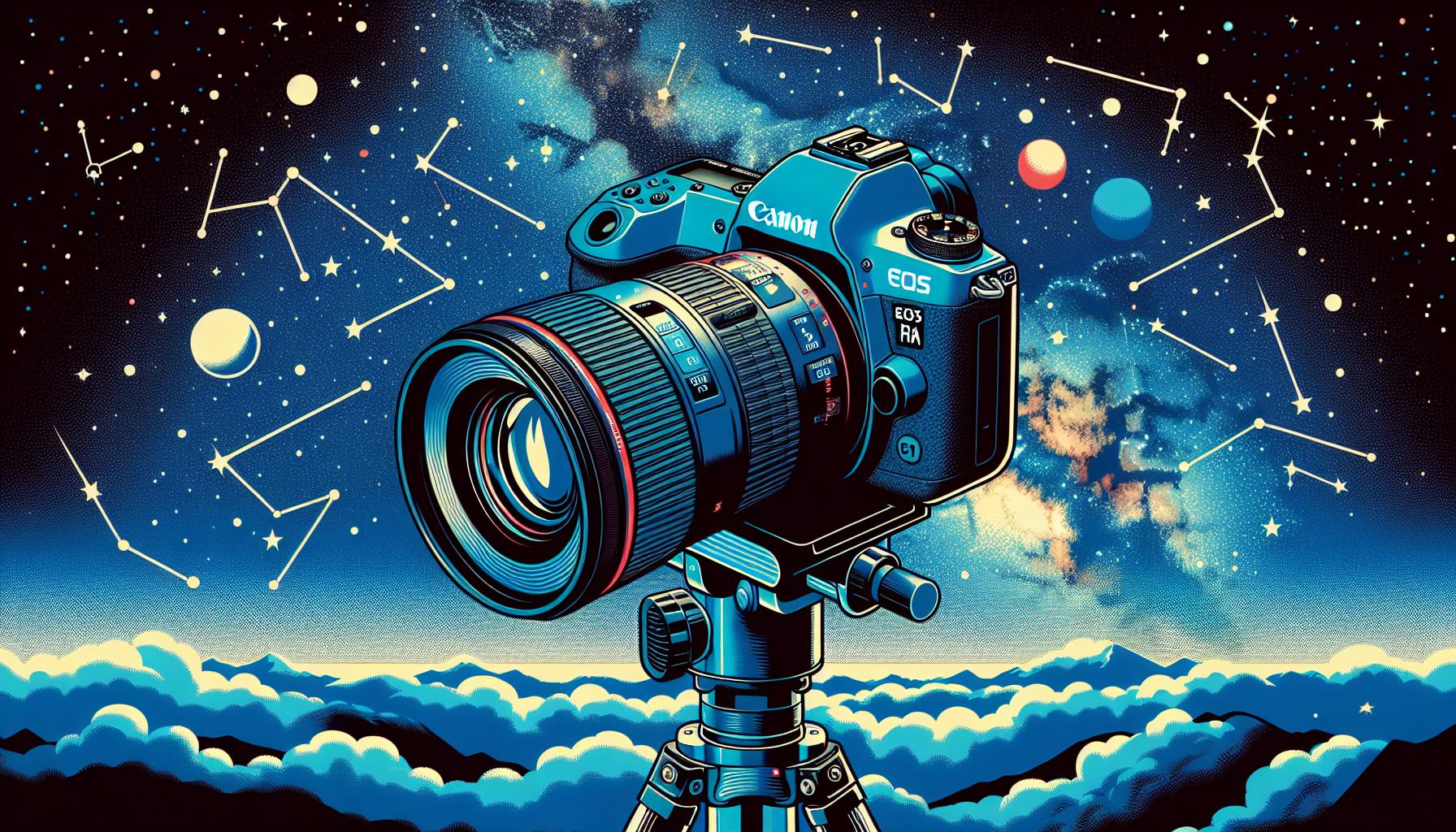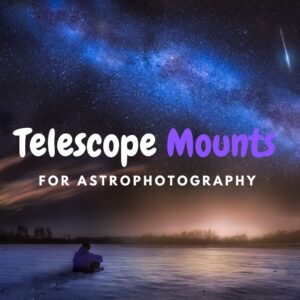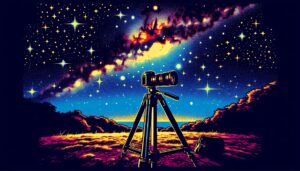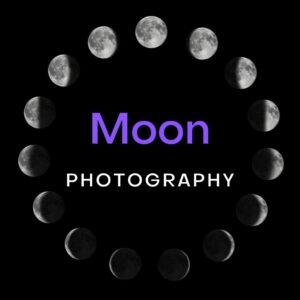This site contains affiliate links to products. I may receive a commission for purchases made through these links.
Astrophotography’s a game-changer, and Canon’s EOS Ra is at the forefront. It’s not just a camera, it’s an astrophotographer’s dream come true. With its specialized features, it’s specifically designed to capture the cosmos in all its glory.
I’ve been using the EOS Ra for some time now, and I can’t stress enough how it’s revolutionized my astrophotography. It’s got a modified filter that allows for greater transmission of deep red infrared rays emitted by nebulae. This means stunning, high-quality images of the night sky.
It’s not just about the tech specs, though. The EOS Ra’s user-friendly interface and ergonomic design make it a joy to use, even in the dark. It’s a tool that truly takes astrophotography to the next level. I’m excited to dive deeper into what makes this camera a star in the world of astrophotography.
Overview of Astrophotography
Astrophotography, at its core, is the art of capturing the beauty of the universe beyond our skies. It’s more than just taking photos; it’s about showcasing celestial objects in a new, breathtaking light, revealing details that our naked eye cannot perceive. The growth of technology, especially in the field of cameras, has opened up new opportunities in this domain. With specialized cameras like the Canon EOS Ra, astrophotography becomes not only possible but also accessible for amateurs and experts alike.
Astrophotography encompasses several areas: planetary, lunar, solar, landscape astrophotography, and deep sky astrophotography. Each area has its own challenges, needs, and equipment. Whether it’s capturing the intricate craters on the moon’s surface, the colorful nebulae, or the patterns formed by stars in the sky, each offers unique satisfaction. Not to mention, it requires distinct sets of equipment and skills to master.
In astrophotography, even the tiniest details can make a substantial difference in the final image, making it essential to have specialized tools. Cameras need to be highly sensitive to infrared rays, possess large sensors, and have significant processing power. Imagine trying to photograph a tiny, dim object millions of miles away in the pitch dark. It’s quite a task! That’s why the Canon EOS Ra is engineered with a modified filter for enhanced deep red infrared rays transmission, rendering it a powerhouse for astrophotography.
While high-performance gear plays a crucial role, let’s not discount the importance of technique and understanding the workings of the night sky. It’s a blend of technical skills, patience, as well as knowledge that bring about the best results. Implementing practices such as stacking images or using long exposure can drastically improve the final image.
With these insights, astrophotography transitions from being a Herculean task to a more approachable, exciting hobby or profession.
Introduction to the Canon EOS Ra
As an avid astrophotographer, I was both intrigued and excited when Canon launched the EOS Ra. Essentially, this camera is a gamechanger in the world of astrophotography. It’s designed with the specific aim of making everything beyond our skies an utterly mesmerizing and easily capture-able experience.
The Canon EOS Ra is a specialized version of the EOS R. While both have a lot in common, it’s the minor tweaks that make a significant difference, or so it’s appeared in my time exploring the features of this remarkable gadget.
There’s an impressive 30.3 megapixel full-frame CMOS sensor that’s married to a DIGIC 8 image processor residing within the sleek frame of the Canon EOS Ra. With an expanded ISO range of 100-40000, Canon is reaching for the stars quite literally.
But what’s different, you ask? Well, it’s equipped with an impressive feature that’s tailor-made for astrophotography – an infrared blocking filter. Offering approximately four times the transmittance of hydrogen-alpha light (656 nm) than the EOS R, this camera’s sensor doesn’t just capture light; it tells a story of different elements present in the deep expanses of space.
Key Features of Canon EOS Ra
- It utilizes a full-frame image sensor
- Equipped with a 30.3 MP CMOS and DIGIC 8 image processor
- Offers an expanded ISO range of 100-40000
- Incorporates an infrared blocking filter
To put it in perspective, let’s have a quick comparison:
| Canon EOS Ra | Canon EOS R | |
|---|---|---|
| Sensor | 30.3 MP Full Frame | 30.3 MP Full Frame |
| ISO Range | 100-40000 | 100-40000 |
| Special Feature | Infrared blocking filter | None |
From the specs, it’s clear that Canon EOS Ra is packing some serious heat expressly for astrophotographers. The brand has taken an already excellent device and turned it into a specialized tool for capturing the beauty of the universe. The astronomical community certainly has another powerful device to look forward to.
Specialized Features of the EOS Ra
Though the EOS Ra shares many aspects with its sibling, the EOS R, when you delve deeper, you discover the enhancements specifically inserted for astrophotography. I’ll walk you through the highlights and how they set the EOS Ra apart.
Of note is the Infrared Blocking Filter. While most DSLRs and mirrorless cameras have this filter to maintain color accuracy in everyday photography, the EOS Ra’s filter is modified. It’s designed to allow roughly four times the amount of transmission of hydrogen-alpha light. This particular wavelength of light is emitted by celestial bodies and is typically blocked by the IR filters on regular cameras. With the EOS Ra, this light passes through, letting you capture deep-sky objects in all their radiant glory.
Understanding the significance of resolution in astrophotography, Canon furnished the EOS Ra with a 30.3 Megapixel Full-Frame CMOS Sensor. This is your ticket to capturing stars as sharp points of light, offering you a detailed and clear view of your stellar subjects.
Expanded ISO Range is another boost for night sky photographers. This runs from 100 to a staggering 40000. While daylight photography might not demand such a range, in astrophotography, it opens new worlds. It enhances low-light shooting, making it smoother and less grainy. The ISO range in the EOS Ra gives you the flexibility to experiment until you reach your perfect balance between noise and detail.
One more perk exclusive to the EOS Ra is the 30x Magnification on both the viewfinder and the LCD screen. This magnification falls directly in line with the needs of astrophotographers who often need to focus manually on distant objects. It ensures that you nail the focus every time.
Each of these elements is a cardinal tool in the arsenal of any serious astrophotographer. And the Canon EOS Ra wraps them all up into one neat package. This camera is a specialized tool, allowing you to explore the cosmos with clarity and precision.
Enhanced Infrared Transmission for Night Sky Photography
When it comes to any form of astrophotography, the ability to capture more light from distant bodies becomes critical. In this department, the Canon EOS Ra doesn’t disappoint with its ability to capture specific light wavelengths – especially the all-important H-alpha light.
The Canon EOS Ra outshines standard cameras with its tweak in the default infrared filter. Typical cameras limit the amount of infrared and ultraviolet light reaching the sensor to prevent color distortions. However, for astrophotography, capturing these light spectrums is vital. The EOS Ra’s particular construction allows for the increased capturing of infrared light. Most remarkable is how it captures a wavelength of 656.28 nanometers (nm), which is in the deep red part of the spectrum also known as H-alpha light.
The reconfigured infrared-blocking filter is the game-changer here. With a transmission factor that’s about four times more sensitive to H-alpha light compared to a typical EOS R, it’s designed to pick up faint stars and nebulae that emit this precise wavelength. This is key for appreciating nebulae’s deep red coloration and understanding more about the composition of distant celestial bodies.
The following markdown table highlights some essential specifications of the Canon EOS Ra compared to the standard EOS R:
| Criteria | EOS Ra | EOS R |
|---|---|---|
| Infrared Filter | Reconfigured for enhanced transmission | Standard |
| H-alpha light sensitivity | 4 times higher | Standard |
| Megapixels | 30.3 | 30.3 |
| ISO Range | Expanded 100-40000 | Standard |
Without a doubt, astrophotographers will appreciate the value of the Canon EOS Ra’s enhanced infrared transmission. It offers rich, precise star clusters and nebulae shots, ultimately reshaping our perceptions of the universe one click at a time.
User-Friendly Interface and Ergonomic Design of the EOS Ra
One of the features that make the Canon EOS Ra a standout is its user-friendly interface and ergonomic design. The EOS Ra is crafted to be efficient and comfortable to use, even in the toughest of conditions which any astrophotographer would appreciate.
Let’s dive a bit deeper into the specifics.
The EOS Ra features a large, high-resolution LCD screen that offers clear, detailed previews of your images. It’s complemented by a crisp electronic viewfinder that’s particularly helpful when you’re shooting in the dead of night with only the stars above to light your way.
Arguably its most convenient feature is the fully articulating screen which provides flexibility – you want to angle your camera upwards to capture the night sky? The EOS Ra has got you covered! Its touchscreen allows you to adjust settings and focus points with just a tap, saving you precious time that could be must better used admiring the cosmos.
It is also worth pointing out that the buttons and dials are logically arranged and easily accessible, even when wearing gloves on a chilly starlit night. Its deep handgrip and lightweight design further contributes to ease of use, providing a comfortable grip for extended periods of time.
What about the EOS Ra’s weatherproofing? Well, whether you’re shooting under a clear sky, or braving the elements for that once-in-a-lifetime shot of a celestial event, you can rely on the EOS Ra to withstand the conditions. Its robust construction includes dust and water resistance, maximising its durability.
Understanding your equipment’s capabilities is paramount for successful astrophotography, and the EOS Ra makes this easy with its customized menu settings and modes tailored for shooting the night sky. This camera has been thoughtfully designed to make newbies feel like seasoned pros and turn seasoned pros into astrophotography legends. As we delve further into the myriad features of the EOS Ra, you’ll see why this camera has become a favorite among astrophotographers worldwide.
Taking Astrophotography to the Next Level with the EOS Ra
Astronomy enthusiasts and professional astrophotographers alike marvel at the Canon EOS Ra’s specialized capabilities. It’s not just a camera, it’s a revolution in the world of astrophotography.
While most cameras solely capture the visible spectrum of light, the EOS Ra’s enhanced infrared transmission gives it an edge. It’s all due to the camera’s reconfigured infrared-blocking filter. This specialized element allows for hydrogen-alpha light capture, emitted by celestial bodies. This light is typically invisible to the human eye and most camera filters. But with the EOS Ra, these far-off vistas become vividly clear.
When it comes to sensor size, the EOS Ra stands out with its 30.3-megapixel full-frame CMOS sensor. This high-resolution sensor ensures every cosmic detail is captured with breathtaking clarity. The details are only as good as the camera’s processing power though, and that’s where the the EOS Ra’s expansive ISO range comes into play. Ranging from 100-40000, the camera’s ISO abilities allow for phenomenal low-light sensitivity, ensuring that even the darkest corners of the universe are within photographic reach.
As far as comparison between the Canon EOS Ra and the standard EOS R, there’s no contest. The modifications in the EOS Ra put it leaps and bounds above its sibling, transforming it from an excellent camera into an extraordinary astro-imaging powerhouse.
Finally, it’s not just the camera’s remarkable performance that impresses. Canon has paired these fantastic features with an ergonomic design and user-friendly interface. Astrophotographers will appreciate the large, high-resolution LCD screen and fully articulating screen for capturing the cosmos from any angle. Featuring logically arranged buttons and dials, the camera makes navigating the settings as effortless as possible. Plus, its weatherproof build and customized menu settings are tailored for taking on the night sky.
The Canon EOS Ra is not just a camera, it’s astrophotography refined, revolutionized, and ready to redefine the boundaries of cosmic exploration.
Conclusion
So there you have it. The Canon EOS Ra isn’t just your average camera. It’s a specialized tool designed for astrophotographers like you and me. With its enhanced infrared transmission, reconfigured infrared-blocking filter, and the ability to capture hydrogen-alpha light, it’s a game-changer in the field. The 30.3 megapixel full-frame CMOS sensor and expanded ISO range make it a powerhouse for capturing the universe’s beauty. What’s more, the user-friendly interface and ergonomic design make it a joy to use. It’s more than just a camera – it’s astrophotography reimagined.
So if you’re looking to push the boundaries of cosmic exploration, the Canon EOS Ra is your ticket to the stars.
FAQ
What are the specialized features of the Canon EOS Ra?
The Canon EOS Ra has been tailored for astrophotography with an enhanced infrared transmission and a reconfigured infrared-blocking filter, allowing it to capture hydrogen-alpha light emitted by celestial bodies. It boasts a 30.3-megapixel full-frame CMOS sensor and has an expanded ISO range of 100-40000.
How does the Canon EOS Ra differ from the standard EOS R?
The primary difference is the EOS Ra’s infrared transmission capability and its specialized infrared-blocking filter, which enable it to capture hydrogen-alpha light emitted by celestial objects. Additionally, it has specific menu settings and modes designed for astrophotography.
What user-friendly features does the Canon EOS Ra camera have?
The EOS Ra features a large, high-resolution LCD screen, a fully articulating screen, and logically arranged buttons and dials. It offers a customized menu designed specifically for astrophotography. It is also weatherproof, providing durability when shooting under various conditions.
How does Canon EOS Ra contribute to astrophotography?
The Canon EOS Ra, with its specialized features and custom settings for astrophotography, allows photographers to capture the beauty of the universe with clarity and precision. Its technical specifications and user-friendly design make it a significant tool for redefining the boundaries of cosmic exploration.




